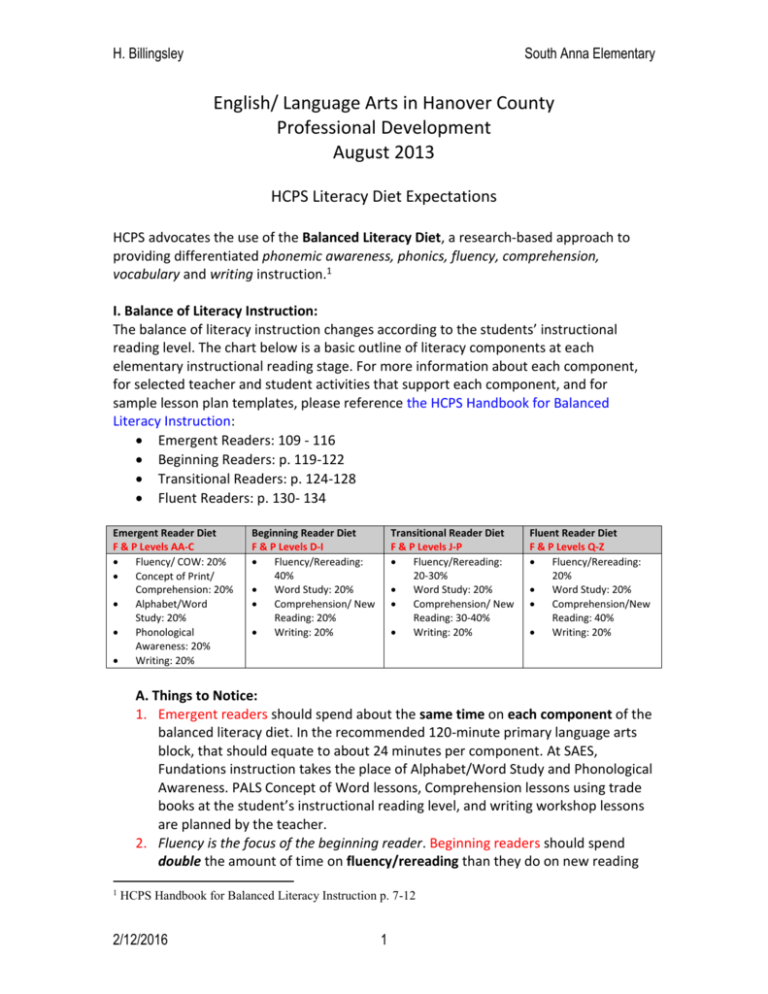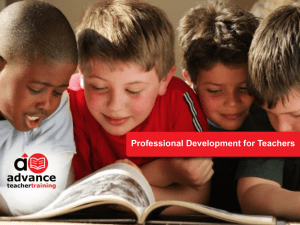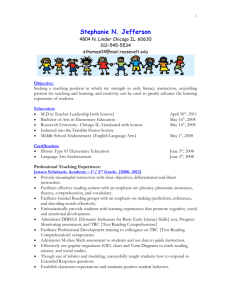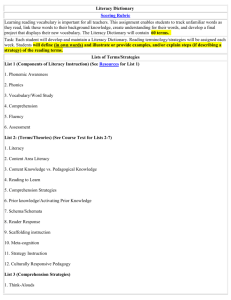Reading/Language Arts Assessment at South Anna
advertisement

H. Billingsley South Anna Elementary English/ Language Arts in Hanover County Professional Development August 2013 HCPS Literacy Diet Expectations HCPS advocates the use of the Balanced Literacy Diet, a research-based approach to providing differentiated phonemic awareness, phonics, fluency, comprehension, vocabulary and writing instruction.1 I. Balance of Literacy Instruction: The balance of literacy instruction changes according to the students’ instructional reading level. The chart below is a basic outline of literacy components at each elementary instructional reading stage. For more information about each component, for selected teacher and student activities that support each component, and for sample lesson plan templates, please reference the HCPS Handbook for Balanced Literacy Instruction: Emergent Readers: 109 - 116 Beginning Readers: p. 119-122 Transitional Readers: p. 124-128 Fluent Readers: p. 130- 134 Emergent Reader Diet F & P Levels AA-C Fluency/ COW: 20% Concept of Print/ Comprehension: 20% Alphabet/Word Study: 20% Phonological Awareness: 20% Writing: 20% Beginning Reader Diet F & P Levels D-I Fluency/Rereading: 40% Word Study: 20% Comprehension/ New Reading: 20% Writing: 20% Transitional Reader Diet F & P Levels J-P Fluency/Rereading: 20-30% Word Study: 20% Comprehension/ New Reading: 30-40% Writing: 20% Fluent Reader Diet F & P Levels Q-Z Fluency/Rereading: 20% Word Study: 20% Comprehension/New Reading: 40% Writing: 20% A. Things to Notice: 1. Emergent readers should spend about the same time on each component of the balanced literacy diet. In the recommended 120-minute primary language arts block, that should equate to about 24 minutes per component. At SAES, Fundations instruction takes the place of Alphabet/Word Study and Phonological Awareness. PALS Concept of Word lessons, Comprehension lessons using trade books at the student’s instructional reading level, and writing workshop lessons are planned by the teacher. 2. Fluency is the focus of the beginning reader. Beginning readers should spend double the amount of time on fluency/rereading than they do on new reading 1 HCPS Handbook for Balanced Literacy Instruction p. 7-12 2/12/2016 1 H. Billingsley South Anna Elementary or any of the other components. In the recommended 120-minute primary language arts block, that should equate to about 48 minutes per component. In a 90-minute block, it would equate to about 45 minutes. At SAES, Fundations instruction takes the place of Word Study instruction for the beginning reader. Students reread familiar texts, build their sight word vocabulary, and echo-, choral- or buddy read to build reading fluency. Comprehension instruction is completed using trade books at the student’s instructional level and/or basal readers. Writing workshop lessons are planned by the teacher and made available through the HCPS Writing Scope & Sequence. 3. Comprehension is the focus of the transitional and fluent reader. Transitional and fluent readers should spend double the amount of time on comprehension/new reading than they do on any of the other component of the balanced literacy diet. In a 90-minute block, it would equate to about 45 minutes. II. How Do I Fit Everything In? HCPS recommends that students in kindergarten through third grade have a 120- 130 minute reading/language arts block and students in grades four and five have a 90 minute to 130 minute reading/language arts block. At SAES, we have tried to ensure that K-2 classes have at least 120 minutes of reading/language arts and 3rd-5th have at least 90 minutes of reading/language arts. If you believe your class requires more time allotted to literacy instruction than currently allotted, please see Mr. Mudd for assistance with scheduling. A. Whole Group Instruction (10-20 minutes)* * At SAES K-2, Fundations instruction will cause this time allotment to increase, as it will decrease the amount of activities/instruction needed to be completed in small group. - Introduce Vocabulary -Shared Reading or Read-Aloud (this is NOT fluency) - Introduce/Model Target Strategy (mini-lesson) p. 25-39 Handbook for Balanced Literacy - Daily Language Review/ Sentence Writing Strategy (more about this later) B. Small Group/ Individual Instruction (50-70 minutes) - Word Study p. 53-60 Handbook for Balanced Literacy; Progression p. 71-82 HfBL - Guided Reading groups/ Daily 5 tasks (Read to Self, Read to Someone, Listen to Reading, Word Work, Work on Writing) - Re-reading familiar texts - Comprehension strategy practice p. 42-46 Handbook for Balanced Literacy - Fluency practice p. 47-48 Handbook for Balanced Literacy - Reading or writing conferences - Small group mini-lessons (if needed) - Vocabulary/ sight word work p. 50 Handbook for Balanced Literacy; p. 61 HfBL - Running records - Intervention groups 2/12/2016 2 H. Billingsley South Anna Elementary C. Writing Workshop (30-40 minutes) p. 84- 103 Handbook for Balanced Literacy - Focus skill mini-lesson p. 94-96 Handbook for Balanced Literacy - Independent student writing/ writing conferences p. 51 Handbook for Balanced Literacy; p.101-103 Handbook for Balanced Literacy - Sharing/ author’s chair III. Organization of Literacy Instruction: - Daily 5 - Guided Reading - Harcourt Trophies Basal 2/12/2016 3








